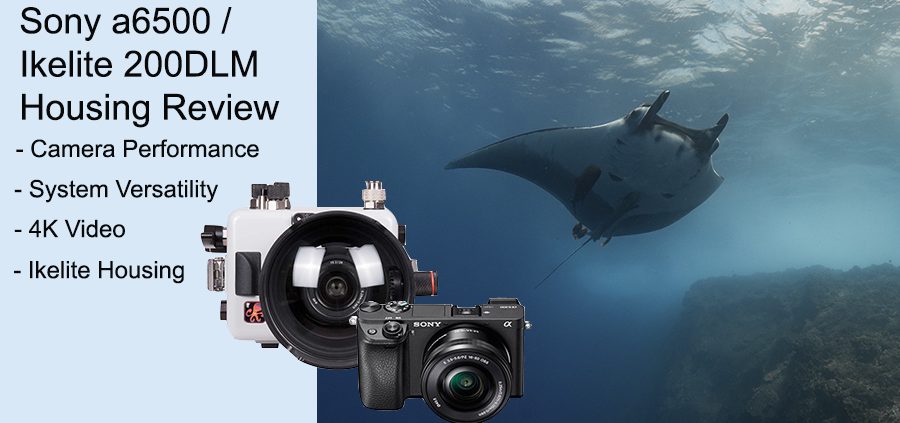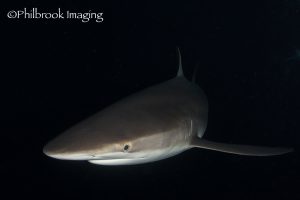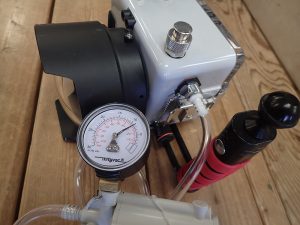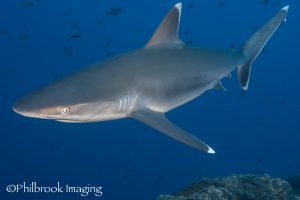Sony a6500 & Ikelite 200DLM Housing Review
 Sony a6500 and Ikelite 200DLM Housing
Sony a6500 and Ikelite 200DLM Housing
Is it possible? Professional 4K video and award-winning 24mp still imaging – all in a small travel-friendly underwater package? Yes…yes it is. Meet the Sony a6500 mirrorless camera and the Ikelite DLM200 housing system.
I have been excited to shoot the new Sony a6500 and test its underwater capabilities since its release, so I jumped at the chance to take the camera and Ikelite’s 200DLM to Socorro to put the system through the paces. This review will cover the strengths and weaknesses of the camera and housing as well as the system’s versatility and compatibility in reference to shooting underwater.
 The Camera
The Camera
First, let’s review the specs. As Sony’s top of the line APS-C mirrorless camera, the A6500 measures up. It is an upgraded model to the popular a6300 by offering greatly improved auto-focus performance, 5-axis image stabilization, and an LCD touchscreen. It retains the a6300’s 24.2MP CMOS sensor (APS-C-size), Hybrid AF system, EVF, 4K 100mbps bit rate video capture capability and weather-sealed magnesium-alloy body.
The a6500 is easy to navigate and manipulate the desired settings. Shutter and aperture controls are independent of each other while the function (FN) button allows for quick access to white balance, ISO, exposure compensation, flash compensation, etc.
The a6500 has a max shutter-sync speed of 1/160 sec. This is relativley slow compared to the competition, which generally allows up to 1/250 sec. Being a mirrorless camera, it is odd and a bit disappointing to lag behind the mirror model cameras on the market (Canon 70D, 80D, Nikon D7200, etc.). Fortunately, with strobes connected to the camera via an electric sync cord, I was able to sync up to 1/250 second.
Image quality is fantastic and just as impressive as any APS-C size sensor camera currently available. It’s dynamic range performance yielded smooth blue water transitions even at higher ISO settings. Autofocus was equally impressive being quick and accurate even in low light situations. The a6500’s autofocus only really struggled at night with no focus light (to be expected!)
Lenses
The a6500 can be used and set-up in a variety of ways. Sony’s 16-50mm kit lens is quite versatile and inexpensive. Ikelite’s DLM 6 inch Dome Port with Zoom allows for full on land angle of coverage and zoom within the compact 6″ dome. For many, this may be all they need for the majority of their underwater imaging. However, If you’d like to unlock more of the camera’s potential with other lenses, this can be done as well!
Thanks to Metabones and Fotodiox adapters, the a6500 can shoot Canon mount lenses. This can be a huge money saver for Canon shooters looking to upgrade without having fork out big $ for new lenses! I was able to use my favorite Tokina 10-17mm fisheye lens, Canon 60mm macro lens, and I even used the Canon18-55mm kit lens to see how it performed. I used the Metabones adapter and am happy to report that autofocus worked flawlessly on all three lenses.
White Balance
If there is an area where the a6500 falls short, it’s white balance. The white balance on the Sony a6500 maxes out at 9900K (Sorry Sony, but that’s just embarrassing!). Although this isn’t a deal breaker, it is essential for those underwater photographers who desire to jump between ambient light & artificial light on the same dive – unless you venture no deeper than 20′. Shooting with ambient light will require you to commit to a filter, which is placed on the back of the lens before it is attached to the camera body. This filter can not be used with artificial strobe or video lights, hence significantly limiting the versatility of the camera on a single dive.
However, once you have committed to ambient shooting, you may custom white balance through the filter in order to get the desired results. Magic Filters work great for this. You can also use the Magic Filter “Auto Magic” and leave the camera’s white balance set to auto, but more accurate results can be achieved by setting your own custom white balance. The good news is that custom white balance is easily set on the a6500. Plus, the system can store up to three different custom white balance settings, which I found very useful while shooting video. With the filter, storing custom white balance settings at 20′, 35′, and 50′ allowed for proper and quick white balance selections at any depth.
Video
The a6500 captures pro quality 4K 30p video at a 100mbps data rate (same codec used in the Sony a7RII and Sony a7S II cameras). When shooting 4K 30p video, the camera records in 6K resolution using a smaller portion of the sensor and then down samples it to 4K resolution. This results in about a 20% smaller crop (common in many cameras) but yields a very sharp video with minimum moire and no pixel binning (pixel binning is designed to reduce noise and improve the signal-to-noise ratio and frame rate but at the expense of resolution). To utilize the full width of the sensor, the a6500 can be shot at 4K 24p. The video quality while shooting 4K is impressive; however, when shooting in 1080p, the results were not nearly as good! I highly recommend shooting in 4K and outputting to 1080p. The video quality is far better! Again, thanks to the Metabones adapter, I was able to shoot wide angle video with the Tokina 10-17mm lens. Even with the 4K cropping factor, I was still able to shoot an underwater angle of coverage of approximately 144 degrees (as opposed to the 180 degree angle of coverage uncropped). The full 180 degree angle of coverage is still possible when shooting 4K 30p with the Canon 8-15mm lens.
The Housing
Ikelite has a long history of making high quality housings at a great price point and their new DLM series is no exception. The 200DLM marks a number of upgrades to previous Ikelite housings for mirrorless cameras.
The housing front is no longer clear. It sports a brand new ABS-PC blend (greyish-white matte finish), which provides strength and corrosion free performance. The back cover remains clear so all camera controls are visible. Allowing for easier viewing, these controls are also marked next to the buttons on the back of the housing.
The housing’s ergonomic design fits all hand sizes well. Kudos to Ikelite for a sleek design that allows very easy access to all the functions desired when shooting underwater (white balance, aperture, shutter, ISO, etc). The 200DLM also has two 1/4-20 mounting cleats at the bottom to allow for your favorite camera tray to be used with it.
Overall, the housing is comfortable, small in size, and easy to manipulate underwater. I opted for the Shutter Trigger Extension, which made for easy firing. This is a great add-on when using Ikelite’s Compact Housing Tray as it comfortably allows shutter button access without any need to search or reach for the shutter button.
Vacuum System
Possibly one the best new Ikelite housing updates is their new Vacuum System. In my opinion, this is a must have as it eliminates any anxiety about a housing’s seal integrity! It is add-on option to any Ikelite housing with a 1/2 accessory port. It can also be installed in place of the 1/4-20 top mount featured on all DSLR housings produced since 2009.
The vacuum system is easy to install and use. After the system is assembled for a dive, simply insert the pump into the vacuum valve and pump out the air within the housing until the pressure gauge on the pump reads between 5-10. Let the housing sit a few minutes, and if the pressure has not dropped on the gauge, disconnect the pump and you’re ready to dive. This not only pulls the seals together eliminating any shallow water flood, but it also eliminates the chance of your port being dislodged during an entry.
Strobe Compatibility
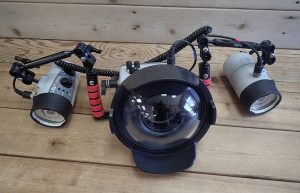 Ikelite has always included their standard electrical sync port on their housings to allow TTL lighting with the use of their Ikelite DS series strobes. However, they recognize that there are many lighting options on the market these days and the 200DLM now ships with two optical ports, which accommodate fiber optic TTL compatibility with INON and Sea and Sea strobes too. This is a welcomed addition and easily makes the 200DLM the most versatile mirrorless housing for strobe compatibility that we’ve tested!
Ikelite has always included their standard electrical sync port on their housings to allow TTL lighting with the use of their Ikelite DS series strobes. However, they recognize that there are many lighting options on the market these days and the 200DLM now ships with two optical ports, which accommodate fiber optic TTL compatibility with INON and Sea and Sea strobes too. This is a welcomed addition and easily makes the 200DLM the most versatile mirrorless housing for strobe compatibility that we’ve tested!
As mentioned earlier, when using the fiber optic ports slaving off the a6500’s flash, TTL is compatible with INON and Sea & Sea strobes. There are some advantages and disadvantages when slaving strobes with the a6500. The TTL is quite accurate and you can take advantage of the many manual EV settings on the INON and Sea & Sea strobes. The down side to this is recycle time can become a factor in fast shooting scenarios and the max flash sync is only 1/160. 1/160 is plenty fast enough for the majority of your shots however, getting tight sunball shot with fill flash is a little more difficult. I did find that when connecting the strobes electrically, I was able to acheive a more desireable max flash sync of 1/250. Ikelite DS series strobes are the only choice if you want TTL compatibility with the electrical connection. If you’re using INON Z-240 or Sea & Sea YS-D1/D2 strobes, they can be connected electrically as well to acheive a 1/250 sync however, the strobes must be shot in manual mode.
Lenses & Port System
Sony does not have the lens selection that Olympus/Panasonic has but with the Metabones or Fotodiox adapters Canon APS-C mount lenses can be used. Thankfully, Ikelite has the ports to support any of the lenses you’d want to use underwater with the a6500. While in Socorro, I mainly shot wide angle with the Tokina 10-17. I used the Modular 8 inch Dome with this set-up when I wanted to shoot at the Tokina’s widest zoom (10mm). Unfortunately Ikelite does not have a zoom sleeve for this lens yet so I had to pre-set my focal length and shoot it as a prime lens. Not a big deal…but a zoom sleeve would make this lens much more versatile, especially when shooting it behind the smaller 6″ dome for close focus wide angle shots. Ikelite has stated that a zoom sleeve is in the works. Yeah! I was also able to use the DLM 6-inch Dome Port with Zoom (for the Sony 16-50mm lens) if I set the Tokina 10-17mm to 13mm (Ikelite has a 6″ port specifically for the Tokina 10-17mm that allows the lens to be used at it’s widest setting without vignetting). I like the small dome option because the overall footprint is smaller and much more travel friendly! I also used this port with the Sony 16-50mm and the Canon 18-55mm lens. Zoom sleeves are available for both these lenses, allowing use through the full zoom range.
One port I would like to see Ikelite add to their lineup is a 67mm threaded flat port with zoom control for the 16-50mm lens. This would make the system even more versatile! With the 16-50mm lens behind a flat port, one would be able to shoot from wide to portrait through the zoom range as well as allow for the attachment of wet mount conversion lenses. This setup would offer options for shooting wide angle to macro all on one dive, which would make the system even more flexible and small for remote travel!
Summary
The Sony a6500 impresses on many levels! Professional 4K video with top quality 24mp still images in a small package. The ability to use Canon APS-C mount lenses, and the easy underwater operation thanks to the FN button, make this camera an easy choice for an underwater photographer. Unfortunately, for the avid videographer, the a6500 may not be considered a home run due to its limiting white balance performance.
Ikelite’s 200DLM housing system for the a6500 is not only built well and ergonomically friendly but it hits a price point that is extremely attractive – and if you are one that cares about service and product support – their customer service is hard to beat as well! The housing is small, robust, and versatile. The DLM200 is able to use Ikelite DS strobes for fast TTL shooting via electrical sync as well as the ability to use INON and Sea & Sea digital TTL strobes! With the addition of their new Vacuum Kit System, and ports to support not only Sony’s 16-50mm, 16-70mm lenses but also Canon APS-C mount lenses such as the Tokina 10-17mm, Canon 8-15mm, and Canon 60mm – this system a meets the mark!

